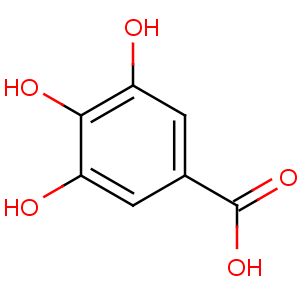Industrial gallic acid
Molecular formula:

Production scale: 1500 tons/year
Synonyms: gallic acid
Chemical name: 3,4,5-trihydroxybenzoic acid
Molecular formula and molecular weight: C7H8O6; 188.13
Properties: white or grayish white crystalline powder, and could be dissolved in 85 shares of water, 6 shares of ethyl alcohol, 2 shares of boiling water, and could be slightly dissolved in the diethyl ether.
Quality index: Conforming to European Standard-93 (First Grade), Japanese National Standard (JIS) Standard (First Grade), 21st edition of USA Pharmacopoeia (Top-Class Product).
Uses: Widely used in such industries as pharmaceuticals, dyes, chemicals and organic synthesis, as well as in the analysis of rare metals.
Storage: Store in an airtight container.
Package: Inner plastic and outer woven bags, 25 kg net weight per bag.
Quality standard:
Content% | ≥99.0 |
Sulfate ppm | ≤10 |
Tannic acid test ppm | ≤1.0 |
Dry weightlessness% | ≤10.0 |
Burning residue% | ≤0.1 |
Turbidity ppm | ≤10 |
Chromatic number | ≤200 |
Gallic acid has many uses in pharmacy, ink, dye, food, light industry and organic synthesis. Gallic acid and ferric ion form blue black precipitate, which is the raw material of blue black ink; It is also used in leather industry; It can also be used as photographic developer. Propyl gallate as antioxidant can be used in edible oil to prevent odor deterioration. In medicine, gallic acid is a hemostatic astringent and a local stimulant of mild chemical book. Application: it has antibacterial effect and can treat bacillary dysentery. It has the functions of astringency, hemostasis and antidiarrhea. It can be used as preservative. It can prepare pyrogallic acid, medicine, ink, mordant dye and explosion-proof agent. It is also used as a developer and analytical reagent for the detection of free inorganic acids, dihydroxyacetone, alkaloids and metals. It can be used as preservative, medium dye and explosion-proof agent.
IUPAC
3,4,5-trihydroxybenzoic acid
SMILES
C1=C(C=C(C(=C1O)O)O)C(=O)O















